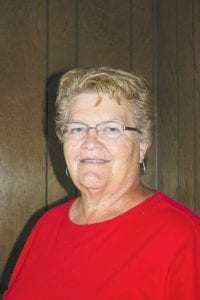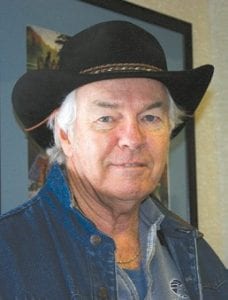Sharon Bloomquist has lived in Cook County since 1961. She has raised five kids here, with three still living in the county with their families. Bloomquist worked at the Grand Marais Senior Center for 20 years. One of her first jobs in Cook County was as a nurse’s aide at North Shore Hospital. She retired from the Council for Aging 2½ years ago and continues to be involved with a variety of volunteer positions. She notes that she has always been involved in care giving in some manner.

The North Shore Hospital & Care Center board of directors faces multiple challenges as the healthcare system changes. To help you learn a little about the folks running for the hospital board, the Cook County News-Herald met with each of the candidates to ask a few questions.
There are three seats open in this election year and all three incumbents are running without opposition.
The candidates are:
Q Recently a “hot topic” has been the Grand Marais burn pile and its potential harmful effects as wind blows smoke down the hill to the hospital grounds. What do you think should be done about this situation?
Sharon Bloomquist: I don’t know if the placement of the city’s burn pile is the right place. I know there is a need for this; if we didn’t have it, we’d find stuff along our roadsides. It just may not be the appropriate place. Where should it be? I don’t know—maybe at the old landfill site.

Howard Abrahamson and his wife, Joan, have lived in Cook County for 25 years and previously summered here. They have “a couple of kids” living in the county. Abrahamson has worked in healthcare directly with Fairview Hospital. He has served on the North Shore Hospital finance committee or on the hospital board for 12 years. He is currently chair of the hospital board. Abrahamson also serves on the Arrowhead Electric Cooperative Inc. and Great River Energy boards. Abrahamson is also one of Cook County’s master gardeners.
Howard Abrahamson: Theycan’t locate it there. Thiswas a problem for the hospital when they had the burner at the school also. Thehospital takes its fresh air from the outside. There is no way to filter the intake. At one point there was talk that the proposed biomass facility would be located in that same area. I do not want to see that.
Thomas Spence, Sr.: I must admit the first time I became aware of this problem was when it was in last week’s paper, so I’m not too knowledgeable about this. I’m not thrilled to learn how it affects hospital operations.
Q What can be done to ensure that our care center continues to be here for our community?
Sharon Bloomquist: The whole hospital board is very aware of the need—and wants to keep—the care center in our community, our folks in our community, so they are close to their support systems and families. We will do what needs to be done to keep this service here. It’s difficult because there are some things we have no control over.

Thomas Spence, Sr. and his wife, Dori, have lived in Schroeder full-time since 1995 and have been Cook County property owners since 1987. Spence is a retired attorney who served as a district court judge in the early 1980s. He recently earned his certification as a hospital board director from the Minnesota Hospital Association.
Howard Abrahamson: Everything we can possibly do. The board is deeply committed to keeping the care center open. It’s very difficult. Ours is one of the last care centers that is publicly owned. We are committed to keeping it part of our hospital. We had a study done, but aside from that study, what you can do is see if there is some commercial interest. We have been bypassed here for years. Our actual operation is different because of our wage structure. The most telling thing is that we are entering our fifth year of no reimbursement from the state. Costs go up; contracts call for increases in wages, but there is no reimbursement. The staff and board do a good job; they are trying hard to economize.
Thomas Spence, Sr.: I think the most important factor in this, in the near- and -long-term future, is a strong affiliation with a larger facility. A small hospital will have a hard time surviving unless it has a relationship, a synergy, with a facility like St. Luke’s. Our contract is going on a year old. It’s a five-year contract, so our main priority is to ensure that it works, and works well, for the hospital and care center. Q
Have you been satisfied with having the Wapiti physicians working in the emergency room?
Sharon Bloomquist: I have not heard of any issues or problems, so I think it’s working. It’s good to have 24/7 coverage without wearing out our clinic doctors. I don’t know how else we’d cover that time. Thecouple times I’ve been in the ER, we’ve received good care.
Howard Abrahamson: We are. Since we’ve switched over to Wapiti we’ve backed away from our clinic doctors. The only problem is the Wapiti doctors spend 24 hours a day, locked in the emergency room, and sometimes see maybe three or four patients. But it is good that we have a consistent workforce.
Nancy (Olson) Rova is our liaison, our paid employee, who manages the doctors for us. We feel that is a kind of quality assurance for us.
The hospital wouldn’t exist if we didn’t have a federally funded clinic and our emergency room. Thefact that we have that subsidy is crucial. We are way ahead of Obamacare. Health care is available in our community even if you can’t afford it because we’ve had sliding scale. If we didn’t have Wapiti and weren’t a critical care hospital, things would be worse. That critical access status means that 104% of our cost for Medicare patients is reimbursed. Thatis 50 – 60% of our patient load. Those extra funds support the hospital and care center.
Thomas Spence, Sr.: I have been. There have been a few bumps, but they have been handled well by administration. I think the few issues were just a matter of becoming familiar with our procedures and that has been worked out. I have not heard any complaints from constituents. The agreement with Wapiti for 24/7 coverage came about because our local doctors had too much on their plate, so I think it’s working.
Q Do you feel North Shore Hospital should offer obstetric delivery?
Sharon Bloomquist: Well, we do—how can you not have it, being 2 ½ hours from the closest hospital? We’ve got to be ready to take care of them. Thenurses and medical staff work hard to stay up-to-date on training and procedures. I understand people wanting to go to Duluth, but it’s a catch-22. It’s hard to train when we don’t have the patients here.
Howard Abrahamson: We still do, to lowrisk patients. At least two of our physicians are adamant that we offer this. The problem is that we don’t want to put the mother at risk. And, without an anesthesiology we cannot do epidurals, which some patients want.
Philosophically, this puts a burden on prospective mothers because they have to be induced.
Thomas Spence, Sr.: I personally would like to see it offered. From talking to the doctors, I understand there are problems with anesthesiology delivery and making sure nurses are up-to-date since not many deliveries are happening here. It’s certainly something I support if we could find a way to do it.
Q How is the management agreement with St. Luke’s working so far?
Sharon Bloomquist: I think it’s working well. Theway the medical industry is going; small organizations have a hard time making it. Being affiliated with St. Luke’s has given us a better perspective of what’s coming down the pike. It gives us someone to lean on.
Howard Abrahamson: It’s been going well. We are one of the last hospitals in the state to become affiliated. It’s the only way tiny hospitals can survive. St. Luke’s has been to every board meeting and extra meetings. We are already seeing extra services, such as a dietician available at the clinic.
Thomas Spence, Sr.: So far I think it’s working very well. Since it’s been in place we’ve had the St. Luke’s CEO or someone else from top management at one of our meetings. They helped immensely in the search for a replacement for Administrator Diane Pearson; they have helped us in the radiology department; they may be helpful with our pharmacy. I think that’s just the tip of the iceberg.


Loading Comments